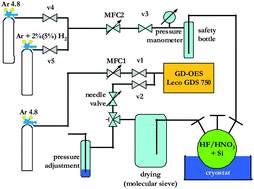Major parts of the mechanism of the wet chemical etching of Si using mixtures of nitric and hydrofluoric acid are still in question. One of them is the issue about the formation of H and its relevance in the oxidation of Si. In the present work H evolution during acid etching of Si was estimated as a function of the HF/HNO3 mixing ratio and the temperature. A commercial GD-OES instrument with an unchanged Grimm type glow discharge chamber was used to determine the amount of formed H. A small fraction of the reaction gases, originated by etching of Si in a PTFE apparatus under Ar atmosphere, was fed by a constant Ar flow via a drying column into the discharge chamber. The gases were excited by the plasma of a continuously DC sputtered Fe sample. Numerous elements like Si, N, O, H, and even B from the B-doped Si were detected. However, only the H emissions at 121.5 nm and 656.3 nm were used for the estimation of the released H. The obtained results show that H is preferentially generated in HNO3-poor etch solutions (HNO3 < 40% (v/v)). In the range from −10 to 35 °C the temperature of the etch solution shows a negligible influence on the H generation, but affects the amount of nitrous gases. This indicates that particularly in HNO3-poor etch solutions the oxidation of Si proceeds to a considerable extent via the formation of H parallel to the already known pathway via the reduction of HNO3.

